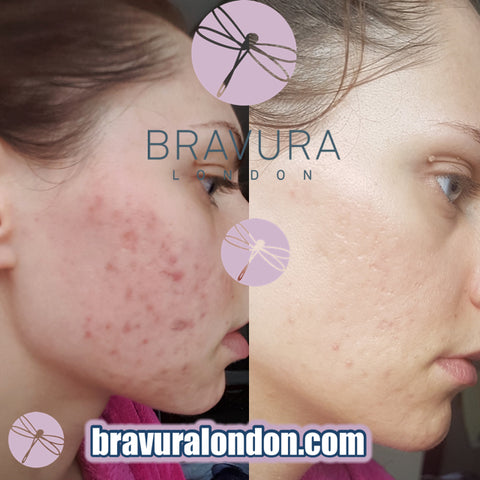Glycolic Acid and How it works
What is glycolic acid
Glycolic acid quite simply is a powerhouse ingredient, suitable for both problem skin and ageing skin. Glycolic acid is also known as an Alpha Hydroxy Acid (AHA), it has the smallest molecules of all the AHA’s which means that it’s able to penetrate a little deeper in to the skin. Due to its excellent capability to penetrate skin, glycolic acid can help reduce the appearance of fine lines and wrinkles, discolouration and hyperpigmentation, breakouts and flaky, dry skin.
Will glycolic acid I use at home leave my skin sore or peeling?
No, over the counter glycolic acid has been designed to be a chemical peel you use at home. It works on the top, dead layer of skin and doesn’t touch the healthy, living skin underneath and so providing you don’t over use glycolic acid, you shouldn't notice any negative results, only healthy, beautiful and glowing skin.
Is glycolic acid natural?
Glycolic acid was originally derived from sugar cane but these days it tends to be lab made, a lot of sugar cane is needed to create a small amount of acid which creates a higher cost and sustainability issues, synthetic glycolic acid is more cost effective and each batch is consistent without the variations which can occur with some natural products.
What are the benefits of glycolic acid?
The top dead layers of our skin are dull, dry and grey and don’t reflect the light. By using the glycolic acid to remove this dead skin, you will have a natural and beautiful glow, fine lines will start to soften, breakouts will reduce, blemishes and mild sun spots will fade and your skin will just look so much healthier and more youthful. Glycolic acid may also stimulate your skin to create more collagen. Collagen is the protein that gives skin its firmness, plumpness, and elasticity, as we age the production of collagen slows down and so anything that stimulates the skin to produce more is essential in any routine where ageing skin is a concern.
How does glycolic acid work?
Glycolic acid help to increase cell turnover, something that slows down as we age. The dead skin on our face and body is held on by a glue like substance, glycolic acid helps to dissolve this glue which then causes the dead skin to simply fall off, you won’t see the dead skin but you will notice your skin looking fresher instantly.
How does Glycolic Acid help spots, blackheads and enlarged pores?
The most common cause of breakouts is when hair follicles get clogged by dead skin cells and sebum - the oil your skin naturally produces. Bacteria multiply within the clogged pores and so spots and blackheads form. By removing the dead skin cells you are also removing the grime and excess oil that's blocking up the pores and exposing fresh, new skin. Most people report that with regular use of AHA products, their once very oily skin becomes more balanced, the less oil your skin produces, the less oil there is to get trapped.
How does Glycolic Acid help mild scars and wrinkles?
Using glycolic acid regularly means you are constantly renewing and regenerating the skin. As mentioned above, glycolic acid can also help to stimulate collagen which gives the firmness, plumpness, and elasticity we have when we’re younger. As we age our skin can also get thinner, this can leave the skin looking uneven in tone, lacklustre and a little sallow, glycolic acid may help to thicken the skin which can help our skin appear more youthful.
No topical treatments can reverse scarring but the Glycolic Acid peels can help to make your skin smoother, and the scars may appear a little softer. Exfoliating also allows your moisturiser to penetrate the deeper and so you’re going to get maximum benefits from your serums and moisturisers.
How often do I need to use Glycolic Acid?
You really don’t need to use glycolic acid often, our 10% glycolic acid for example is used no more than once every other day. If you want to alternate it alongside other acids, you would alternate between each acid every other day, leaving a day break from exfoliating. Lower strength acid products like our Revitalising Ginseng Toner can be used daily.
Why does the PH matter for Glycolic Acid?
The PH of glycolic acid is important and needs to be low enough to work efficiently but not so low that it causes irritation. Our glycolic acid has a PH of around 3 (apples have a PH of between 3-4) which we find is the optimal strength. Acids can sound a little scary but these products have been formulated to be safe to use at home, lemon juice has a lower PH than any of our products.
Can I use retinol while using Glycolic Acid?
Yes, you can use over the counter products. Depending on the strength, if it’s a low strength some people can use it directly after the acid, with higher strength or prescription strength products, it's best these are used on the days that you don’t use your glycolic acid. If you have been prescribed a high strength retinol, speak to your Dr regarding the use of acids alongside your treatment.
Can I use Vitamin C alongside Glycolic Acid?
Again the same as the retinol, it depends on the strength. If it’s a low strength some people can use it directly after the acid, a higher strength (above 10%) is best used on the days that you don’t use your glycolic acid.
I’m pregnant or breastfeeding, can I use Glycolic Acid?
This is all down to personal choice. There are no safety concerns regarding the use of glycolic acid during pregnancy or breastfeeding but anything applied to our skin can be absorbed in to our bloodstream and so some people prefer to avoid acids because of this potential.
Can I just use Glycolic Acid and nothing else?
A daily skincare routine is very important, although glycolic acid is an amazing product, it won't give you the best results if you only use it a few times a week but don't cleanse and moisturise daily.
Glycolic Acid vs Salicylic Acid
This is a very basic explanation, for more info on our home use salicylic acid chemical peel, please visit our blog on Salicylic Acid. Both are amazing ingredients that work in different ways. Glycolic Acid is an AHA which is water soluble, it has a larger molecular structure which means it is able to stay on the surface, working to help reduce the appearance of dead skin, discolouration, blemishes and any imperfections. Salicylic acid is oil soluble, it works within the pores helping to break down the dirt and blockages within the pore and does also help to exfoliate the skin.
The amazing thing about our home use chemical peels is that you can use whichever is suitable for your skin, that could be one or all 3! You alternate between each one at least every other day or use on certain areas, for example you can use the salicylic acid to help with blackheads on the nose and glycolic acid on the forehead to help reduce the appearance of wrinkles or discolouration.
Glycolic acid before and after
Here are some before and after pictures from customers that have used our glycolic acid peel alongside a great, daily skincare routine.



Shop GLYCOLIC ACID today, we offer next day delivery and free standard post in the UK for orders over £25, we also ship worldwide.

